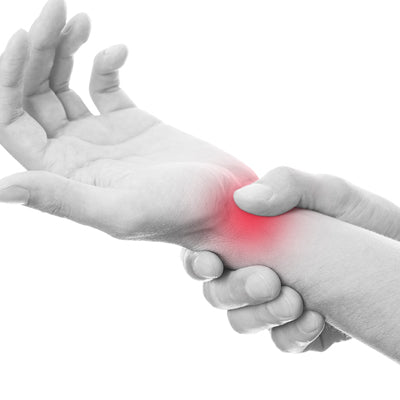
What is a Sprain?
Have you ever twisted your ankle, caught yourself during a fall, or twisted your knee and wondered if the pain you were experiencing after the incident was a sprain? A sprain involves the ligaments which connect the bones at a joint. When those ligaments get stretched or torn, you have sprain. There are three types of sprains: mild, moderate, and severe. Expand below to read more about the types of sprains.
Sprain Causes
If you fall, twist a joint in the wrong way, or get a contusion near a joint, a sprain can occur. This occurs mostly when you fall and try to catch yourself, pivot on your knee, or overextend a joint during an activity.
It's easy to roll an ankle or twist a knee playing basketball, tennis, or while exercising and jogging. That is why sprains are one of the most common sports-related injuries. If you're walking across an uneven or slippery surface and you slip, you can overextend or twist a joint, which may cause a sprain. While walking up and down stairs, you can easily roll your ankle or twist your knee. If you've fallen, or hurt yourself during sports or exercise, or were injured on stairs, a sprain could be likely.
Risk Factors
There are many risk factors of sprains. If you do not regularly exercise, your may have some muscle weakness which would make you more susceptible to injury. Even just being tired can lead to a greater likelihood of an injury. Not warming up prior to exercise can also be a risk factor for a sprain. Wearing ill-fitting shoes or walking on ice or other slippery surfaces can also lend itself to a joint injury.
Symptoms
With a sprain, you're going have pain, bruising, swelling and inflammation, and limited movement in the affected joint. You might even hear a pop or a tear when the injury occurs. Sprain symptoms can last as little as two days or up to several weeks or months depending on the severity of the injury
Strain Vs. Sprain Which is Worse?
You may also be wondering about the difference between sprains and strains. A sprain involves the ligaments as we discussed above. A strain involves an injury, over-stretching or tearing, to muscle or tendons. Many of the symptoms are similar such as pain, swelling, and limited movement. But while you might see bruising on a sprain, you won't see that on a strain. With a strain, you're more likely to feel muscle spasms, which don't occur with a sprain. Strains can also be caused by more than just a one-time injury. Repetitive movements while on the job or playing a sport like tennis or golf can cause as strain.
Treatment
Sprain treatment depends on the severity of the injury. For mild injuries, the first treatment is to practice RICE, which stands for Rest, Ice, Compression, and Elevation. First rest, sit or lie down when possible. Avoid activity and exercise. Next, apply ice to the injury as soon as you can. Make sure to put a thin cloth between your skin and the ice. Ice for about 10-15 minutes at time with an hour between icings. Try it at least 3 times a day until swelling recedes. The third is compression; you can wrap the injured area with an elastic bandage or tape it, especially when you have to be on your feet. The last is elevation. When you are able to sit down, prop the affected area up on a chair or foot stool. If you're lying down, place a few pillows under the injury to keep it elevated.
There are many safe ways to treat a sprain naturally. Therapeutic massage can increase circulation and speed up healing. A chiropractor can assist by manipulating the joint and recommending specific exercises. There are also many safe natural herbal remedies that can be used; for example, look for a natural joint and muscle pain relief cream to sooth the aching joint. There are many nutrients, supplements, and herbs - used topically or taken orally - that can be useful in helping the body's natural ability to heal damaged ligaments and reduce swelling.
Sprain Healing Time
If you cannot walk more than four steps without significant injury, you cannot move the injured area, are experiencing any numbness or tingling, or it's been more than 2 weeks and you're still having symptoms, you should see a doctor. You may have a severe sprain that requires physical therapy and maybe even surgery to repair a torn ligament.
Most sprains are mild or moderate and can be dealt with at home on your own. Be sure to know the difference between a sprain and a strain and know how to treat them properly. Follow the RICE protocol and look for natural remedies to speed up the healing process. You'll be back on your feet in no time!
Sources:
https://www.niams.nih.gov/health_info/sprains_strains/sprains_and_strains_ff.asp
http://www.mayoclinic.org/diseases-conditions/sprains-and-strains/basics/symptoms/con-20020958
http://orthoinfo.aaos.org/topic.cfm?topic=a00111
http://www.healthline.com/health/sprain-vs-strain#overview1
http://www.umm.edu/health/medical/altmed/condition/sprains-and-strains


 {{/image.src}}
{{/image.src}}





